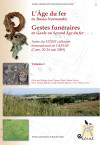
- Résumé
-
Le projet ArchaeDyn poursuit une expérience de recherche collective amorcée par les programmes européens Archaeomedes I « Understanding natural and anthropogenic causes of soil degradation and desertification in the mediterranean basin » (1992-1994) et II « Policy-relevant models of the natural and anthropogenic dynamics of degradation and desertification and their spatio-temporal manifestations » (1996-1999). Ces programmes successifs ont eu pour objet l’analyse de l’évolution du système de peuplement dans la longue durée, de l’Antiquité au Moyen Âge. Le programme ArchaeDyn contribue à élargir la problématique de la recherche, en abordant la dynamique des territoires, envisagée selon plusieurs angles d’étude, tant au plan thématique, chronologique que spatial. Le projet a pour objectif d’approfondir l’analyse des interactions spatiales entre des groupes sociaux, les ressources qu’ils exploitent pour assurer leur subsistance, produire des objets et échanger avec d’autres groupes à courte, moyenne et longue distance, et les itinéraires qui régissent les flux à différentes périodes.
- Sommaire
-
Scientific committee
Steering committee
Partners
Presentation ArchaeDyn
Archaedyn’s members
Acknowledgments
Program
Presentation concert Laostic
Articles
Introduction
Laure Nuninger and François Favory
SESSION 1 “METHODS AND TOOLS OF SPATIAL ANALYSIS” (workgroup 4)
Oral communications
Models and tools for territorial dynamic studies
L. Nuninger, L. Saligny, K. Otir, N. Poirier, E. Fovet, C. Gandini, E. Gauthier, . Kokalj, F. Tolle with the collaboration of the ArchaeDyn team
Managing complexity the simple way: examples from gis modelling of human behaviour.
Benjamin Ducke, Peter C. Kroefges
Agent-Based Modeling and its Application to Prehispanic Settlement Ecodynamics in the Central Mesa Verde Region: Testing Optimality in Site Location in the Archaeological Record.
Timothy Kohler
Estimations of population densities from the Neolithic up to the 19th century: methods and results.
Johanna Hilpert, Andreas Zimmermann
Interpretive dimensions and variability of population densities.
Andreas Zimmermann, Johanna Hilpert
SESSION 2 “CATCHMENT AREAS, TERROIRS AND COMMUNITY LANDS” (workgroup 1)
Oral communications
The spatio-temporal dynamic of agricultural areas, from Antiquity to modern period (ArchaeDyn Project).
Nicolas Poirier, Murielle Georges-Leroy, Florian Tolle, Elise Fovet
Subsistence, sustainability and population at Tell Al-Rawda: a 3rd Millennium BC town in the Syrian steppe/ Autosuffisance alimentaire et population à Tell Al-Rawda: une ville du troisieme millenaire dans la steppe syrienne.
Olivier Barge, Corinne Castel
Catchments, settlement chambers and demography: case studies and general theory in the Greek landscape from prehistory to early modern times.
John Bintliff
Posters
Spatial analysis of archaeological sites in the Châtillonnais forests (Côte-d’Or, France).
Sandra Aussel, Dominique Goguey, Yves Pautrat, Laure Saligny, A. Charmot, Claude Mordant, Laure Nuninger
Characterization of Agrarian Resources for Archaeological Applications (ArchaeDyn Project).
Elise Fovet, Nicolas Poirier
Diet of ancient and middle Neolithic populations in the northwest of Mediterranean. Anthropological and isotopic studies
Gwenaëlle Le Bras-Goude
SESSION 3 “SETTLEMENT PATTERNS, NETWORKS AND TERRITORIES” (workgroup 2)
Oral communications
The spatio-temporal dynamics of settlement patterns from 800 bc to 800 ad in central and southern gaul: models for an interregional comparison over the long term.
Frédérique Bertoncello, Elise Fovet, Cristina Gandini, Frédéric Trement and Laure Nuninger with the collaboration of the members of Workgroup 2
The uncorrupting mountain. Historical dynamics in the Iberian Mountain Range from 5.500 B.C. to 1.800 A.D.
Francisco Burillo, Jesús Arenas, Jesús Picazo, Julián Ortega, Clemente Polo, Carolina Villagordo, Raul López, Esperanza Saiz
GIS as a means to investigate «Princely Sites», Space and Environs. New ways to answer old questions.
Axel Posluschny
Changing settlement patterns in the Normandy countryside.
Benjamin Van Den Bossch, Cyril Marcigny
Posters
Using ArcGIS Spatial Analyst for the investigation of the system of habitation in the Kislovodsk basin (South of Russia).
Dmitry Korobov
Rural settlement dynamic during Iron Age in Central Gaul: the excavation and fieldwalking data head to head
Pierre Nouvel, Philippe Barral
SESSION 4 “DIFFUSION OF RAW MATERIALS AND MANUFACTURED OBJECTS” (workgroup 3)
Oral communications
Models for the study of the consumption and the circulation of resources and products in France and Western Europe during the Neolithic and the Bronze Age (ArchaeDyn project)
Estelle Gauthier, Olivier Weller, Laure Nuninger et avec la collaboration de : Maréva Gabillot, Bénédicte Quilliec, Pierre Petrequin
Mobility and circulation of knowledge among potters of the Arewa (South-Western Niger): impact of the frameworks of practice on the spatial distribution of ceramics’ techniques.
Claire Corniquet
Posters
Pin consumption on the shores of lake Neuchâtel (Switzerland) during the palafittic Late Bronze Age.
Viktoria Fischer
Spatial analysis of the Salt Spring exploitation in Moldavian Pre-Carpatic Prehistory (Romania).
Olivier Weller, Robin Brigand, Laure Nuninger
SESSION 5 OPEN SYNTHETIC SESSION
Oral communication
Bilan général du programme triennal ArchaeDyn/synthesis of ArchaeDyn project ArchaeDyn 2005-2007 : ambitions, achievements and accomplishments
François Favory, Laure Nuninger
- Auteur(s)
-
Cristina GANDINI (dir.)Docteure en archéologie spatiale, allocataire de recherche ATER, Laboratoire AOROC-ENS Ulm, UMR 8546François FAVORY (dir.)Porteur du projet Archaedyn, professeur d'histoire ancienne et archéologie gallo-romaine, Laboratoire Chrono-Environnement, UMR 6249.Laure NUNINGER (dir.)Coresponsable du projet Archaedyn, Chargée de recherche CNRS en archéologie spatiale, Laboratoire Chrono-Environnement, UMR 6249.
- Public
-
Archéologues et historiens : antiquisants, médiévistes ; chercheurs confirmés, archéologues bénévoles, doctorants, étudiants, amateurs éclairés de l’archéologie.
- éléments téléchargeables
- Soutien(s)
-
CNRS – université de Bourgogne – MSH Dijon (UMS 2739) – MSHE Besançon (UMS 3124) – région Bourgogne – région Franche-Comté – ville de Dijon.












